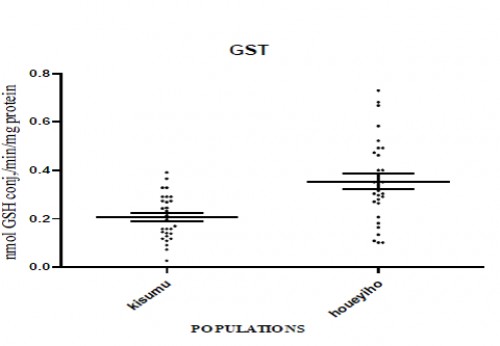Abstract: A study carried out in a vegetable farming area (Houeyiho) in southern Benin, showed that despite the benefits coming from this activity, its development contributes to the emergence of multiple insecticide resistance in malaria vectors.
To verify this hypothesis, we reared wild mosquitoes’ larvae collected from a vegetable farming area during dry and rainy seasons. Bioassay were performed on the emerging adult mosquitoes to assess the susceptibility of malaria vectors to insecticide-impregnated papers (permethrin 0.75%, delthamethrin 0.05%, DDT 4%, and bendiocarb 0.1%) following WHOPES guidelines. An. gambiae complex, knock down resistance (kdr) and acetylcholinesterase (ace-1) mutations were determined by Polymerase Chain Reactions (PCR).
Enzymatic mechanisms (Glutathione-S-Transferase, esterase, monooxygenase P450 and total protein) were also investigated from the F1 (the parental population after breeding) populations of An. gambiae s.l.
Results from this study showed that: a)-A wide range of pesticides is abusively used by farmers for crop protection which would have contributed to insecticide resistance in An. gambiae populations to organochlorines (average mortality rate = 1.19%) and pyrethroids (average mortality rate = 29%) but remains susceptible to carbamate (average mortality rate = 100%); b)-kdr mutation was found with a 0.95 frequency. The Ace-1 mutation was also detected but at a very low frequency (≤ 5%); c) -The presence of enzymatic activities was observed in the wild An. gambiae populations particularly GSTs and P450 oxidase which had significantly elevated levels compared to the susceptible Kisumu strain.
Our research has shown that vegetable farming activity in Benin contributes to the emergence of multiple insecticide resistance in malaria vectors. The widespread pyrethroid resistance in malaria vectors reported in this study is a significant limitation to the use of LLINs (Long-Lasting Insecticidal Nets) as a malaria vector control strategy in many areas in southern Benin. Moreover, our findings clearly showed the presence of metabolic resistance mechanisms in malaria vectors. These findings suggested that metabolic resistance may be associated with resistance to different classes of insecticides



